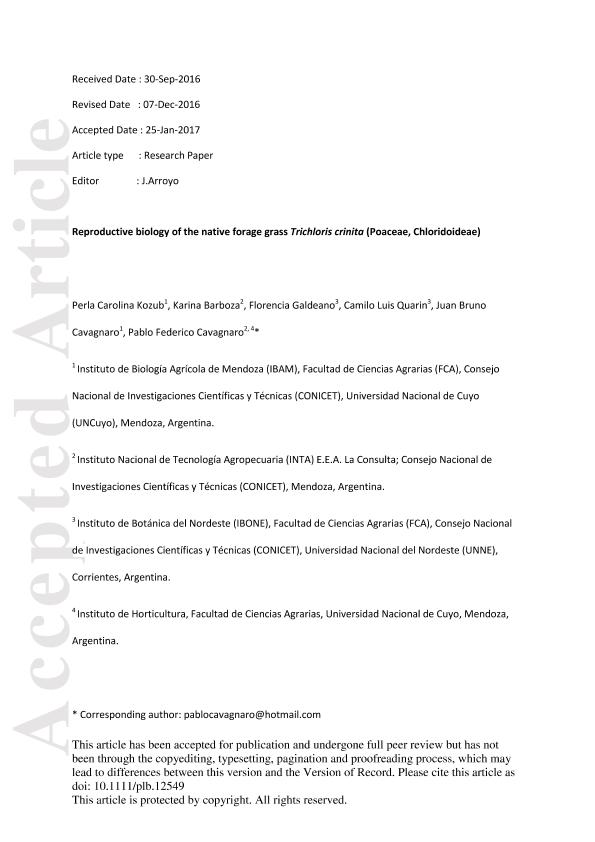Mostrar el registro sencillo del ítem
dc.contributor.author
Kozub, Perla Carolina

dc.contributor.author
Barboza Rojas, Karina

dc.contributor.author
Galdeano, Florencia

dc.contributor.author
Quarin, Camilo Luis

dc.contributor.author
Cavagnaro, Juan Bruno

dc.contributor.author
Cavagnaro, Pablo Federico

dc.date.available
2018-03-26T17:34:37Z
dc.date.issued
2017-05
dc.identifier.citation
Kozub, Perla Carolina; Barboza Rojas, Karina; Galdeano, Florencia; Quarin, Camilo Luis; Cavagnaro, Juan Bruno; et al.; Reproductive biology of the native forage grass Trichloris crinita (Poaceae, Chloridoideae); Wiley Blackwell Publishing, Inc; Plant Biology; 19; 3; 5-2017; 444-453
dc.identifier.issn
1435-8603
dc.identifier.uri
http://hdl.handle.net/11336/39927
dc.description.abstract
Trichloris crinita is a perennial forage grass species native to arid regions of the American continent. Due to its extensive area of distribution, good forage quality and resistance to drought and grazing, this species is widely utilised as forage and for revegetation purposes in environments with low water availability. Despite its importance, genetic improvement of T. crinita has been very limited, partly as consequence of the lack of knowledge on its mode of reproduction. In the present work, we studied the reproductive biology of T. crinita by means of embryological analyses, flow cytometric seed screen (FCSS), self-compatibility tests and progeny testing with morphological and molecular markers. Cytological analyses revealed embryo sacs with eight nuclei and of Polygonum type for all T. crinita accessions analysed. FCSS histograms exhibited two clear peaks corresponding to 2C and 3C DNA content, indicating embryo sacs of sexual origin. Controlled pollination experiments designed to evaluate seed set (%) demonstrated that T. crinita is self-compatible, whereas results from morphological and simple sequence repeat (SSR) marker analysis of progeny revealed lack of outcrossing. Together, these results indicate that T. crinita reproduces sexually. It is a self-compatible and autogamous species. It is expected that these data will have a positive impact in the genetics and breeding of this species, and therefore contribute to its proper utilisation in arid regions.
dc.format
application/pdf
dc.language.iso
eng
dc.publisher
Wiley Blackwell Publishing, Inc

dc.rights
info:eu-repo/semantics/openAccess
dc.rights.uri
https://creativecommons.org/licenses/by-nc-nd/2.5/ar/
dc.subject
Autogamy
dc.subject
Embryological Analysis
dc.subject
Flow Cytometry
dc.subject
Microsatellites
dc.subject
Molecular Markers
dc.subject
Sexual Reproduction
dc.subject
Trichloris
dc.subject.classification
Agricultura

dc.subject.classification
Agricultura, Silvicultura y Pesca

dc.subject.classification
CIENCIAS AGRÍCOLAS

dc.title
Reproductive biology of the native forage grass Trichloris crinita (Poaceae, Chloridoideae)
dc.type
info:eu-repo/semantics/article
dc.type
info:ar-repo/semantics/artículo
dc.type
info:eu-repo/semantics/publishedVersion
dc.date.updated
2018-03-23T18:19:30Z
dc.journal.volume
19
dc.journal.number
3
dc.journal.pagination
444-453
dc.journal.pais
Reino Unido

dc.journal.ciudad
Londres
dc.description.fil
Fil: Kozub, Perla Carolina. Consejo Nacional de Investigaciones Científicas y Técnicas. Centro Científico Tecnológico Conicet - Mendoza. Instituto de Biología Agrícola de Mendoza. Universidad Nacional de Cuyo. Facultad de Ciencias Agrarias. Instituto de Biología Agrícola de Mendoza; Argentina
dc.description.fil
Fil: Barboza Rojas, Karina. Instituto Nacional de Tecnología Agropecuaria. Centro Regional Mendoza-San Juan. Estación Experimental Agropecuaria La Consulta; Argentina. Consejo Nacional de Investigaciones Científicas y Técnicas. Centro Científico Tecnológico Conicet - Mendoza; Argentina
dc.description.fil
Fil: Galdeano, Florencia. Consejo Nacional de Investigaciones Científicas y Técnicas. Centro Científico Tecnológico Conicet - Nordeste. Instituto de Botánica del Nordeste. Universidad Nacional del Nordeste. Facultad de Ciencias Agrarias. Instituto de Botánica del Nordeste; Argentina
dc.description.fil
Fil: Quarin, Camilo Luis. Consejo Nacional de Investigaciones Científicas y Técnicas. Centro Científico Tecnológico Conicet - Nordeste. Instituto de Botánica del Nordeste. Universidad Nacional del Nordeste. Facultad de Ciencias Agrarias. Instituto de Botánica del Nordeste; Argentina
dc.description.fil
Fil: Cavagnaro, Juan Bruno. Consejo Nacional de Investigaciones Científicas y Técnicas. Centro Científico Tecnológico Conicet - Mendoza. Instituto de Biología Agrícola de Mendoza. Universidad Nacional de Cuyo. Facultad de Ciencias Agrarias. Instituto de Biología Agrícola de Mendoza; Argentina
dc.description.fil
Fil: Cavagnaro, Pablo Federico. Consejo Nacional de Investigaciones Científicas y Técnicas. Centro Científico Tecnológico Conicet - Mendoza; Argentina. Instituto Nacional de Tecnología Agropecuaria. Centro Regional Mendoza-San Juan. Estación Experimental Agropecuaria La Consulta; Argentina. Universidad Nacional de Cuyo. Facultad de Ciencias Agrarias. Departamento de Producción Agropecuaria. Cátedra de Horticultura y Floricultura; Argentina
dc.journal.title
Plant Biology

dc.relation.alternativeid
info:eu-repo/semantics/altIdentifier/url/http://onlinelibrary.wiley.com/doi/10.1111/plb.12549/full
dc.relation.alternativeid
info:eu-repo/semantics/altIdentifier/doi/http://dx.doi.org/10.1111/plb.12549
Archivos asociados
